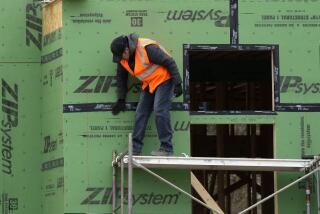Reports Suggest Recovery Is Slowing
- Share via
WASHINGTON — Construction spending edged up modestly in October, led by a surge in school construction and single-family homes, but a principal indicator of health at U.S. factories showed that manufacturing shrank for a third straight month.
Analysts said Monday’s reports, which followed a surprisingly strong start to the holiday shopping season, depicted an economic recovery that appears to be slowing but not stalling.
The Institute for Supply Management said its closely watched index of manufacturing activity remained below the 50 mark, which separates expansion from contraction. The index was 49.2 in November, up from 48.5 in October.
U.S. factories have suffered the most from last year’s recession, as more than 2 million factory jobs have been lost over the last two years.
A new wave of layoffs was announced this fall as companies trying to keep their stock prices from further deterioration pared their payrolls.
But the Commerce Department reported that construction spending rose 0.3% in October, the gain reflecting strength in building schools and single-family houses. Home sales have been red-hot all year, spurred by the lowest mortgage rates since the mid-1960s.
Analysts said the contrast between a struggling manufacturing sector and strength in consumer spending and construction showed the crosscurrents buffeting the economy.
“Once again the consumer is doing his job, but it is still the business sector having problems,” said David Wyss, chief economist at Standard & Poor’s in New York.
“All is yet to be right in the manufacturing heartland,” said Joel Naroff, head of a Holland, Pa., forecasting firm.
Gerald Cohen, senior economist at Merrill Lynch in New York, said he believed consumer demand, which accounts for two-thirds of the nation’s economic activity, would hold up enough to allow the economy to grow at a 1.5% rate in the final three months of the year.
That would be far below the third-quarter growth rate of 4% but would not constitute the double-dip recession some have feared.
The Commerce Department’s report on construction activity showed a rise to a seasonally adjusted annual rate of $834.6 billion in October, compared with $832.5 billion in September.
Increases in September and October followed a 1% decline in August.
October’s gain in construction was led by a 1% increase in spending for nonresidential buildings, which rose to an annual rate of $158.3 billion.
This increase came after five consecutive monthly declines, as uncertain prospects have kept businesses from making new capital investments.
Sectors that cover factories and office buildings remained down in October, but this was offset by increases in other areas, including a 10% jump in spending on educational buildings and a 2.2% rise in spending on hospital construction.
Spending for construction of homes and apartments was up slightly to $412.3 billion in October, a 0.05% rise from September’s level of $412.1 billion. However, spending for single-family homes posted a 1% advance, offsetting weakness in apartment building.
Residential construction has been among the leading bright spots in the uncertain economic recovery as the lowest mortgage rates in a generation spurred record home sales.
Government spending dropped 0.3% in October to an annual rate of $205.4 billion after a 1.6% surge in September.
The weakness was led by a 3.8% decline in highway construction, one of the biggest categories in the government sector.
More to Read
Inside the business of entertainment
The Wide Shot brings you news, analysis and insights on everything from streaming wars to production — and what it all means for the future.
You may occasionally receive promotional content from the Los Angeles Times.










